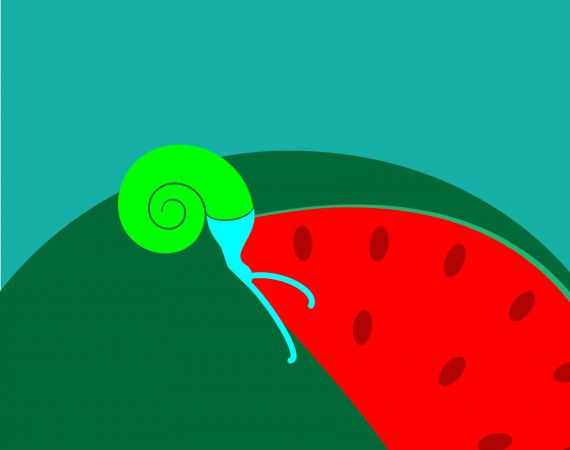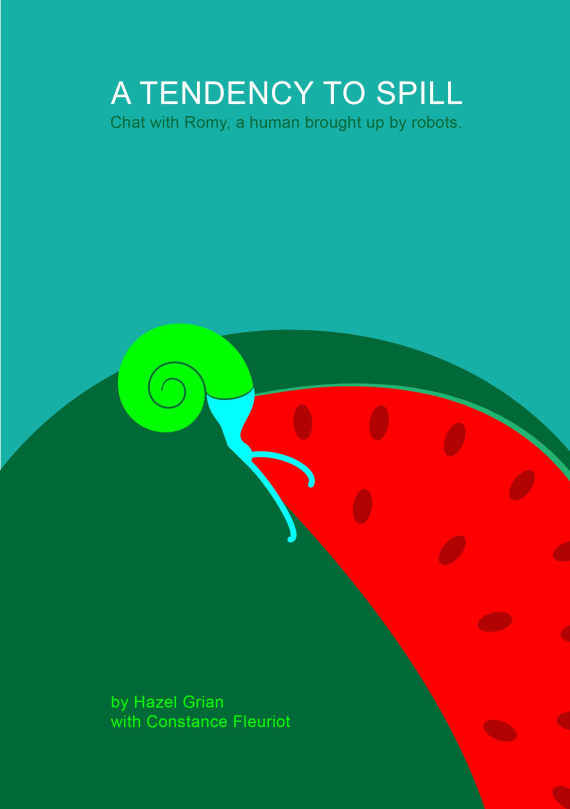Posted on Fri 30 Jun 2017
A Tendency To Spill: the story synopsis.
Original sin: Science Fiction tropes are up-ended in this Margaret Atwood-like Young Adult story, inventively told through instant messaging.

Posted by

Hazel Grian
A pioneer of interactive drama, specialising in robots, Hazel began as a live performer & filmmaker. In a 35 year career, she is driven by her ambition to bring stories to audiences by ‘any medium necessary’.Project

A TendencyTo Spill: using a chatbot as a storytelling platform.
This project began with an 1100-word short story I wrote a couple of years ago. I wanted to find out how much more of an intensely intimate reading experience I could create by using one-to-one digital interactivity.
3D printed people! Human children adopted then banished at puberty.Try the chat-bot story A Tendency To Spill
I’ve written a review of our chatbot story. Because there are no digital story critics.This blogpost explains the story world in full.
A teenager in a world of robots has just discovered she’s actually human. It’s like finding out you’re adopted..and you're an illegally imported wild animal. The consequences are severe: instant expulsion across The Wall. That’s where you come in. Romy acts resourcefully and gets through to us humans online. She asks for the low down on whether she’ll be treated OK, or if the human world is as horrible as they say. A Tendency To Spill is an interactive Science Fiction story that involves a chat bot, that’s instant chat using artificial intelligence. You’re not chatting with a real person but computer coding and when it works best you forget that and are captivated. Romy asks you for a crash course in what’s really at the heart of human society. The name of the country is unknown, the location of the city and the date are also unknown. We could be 100 years in the future where 3D printing has developed enough to produce a population of synthetic people. A wall separates the robots who live in one culture, from the humans who have a very different one. We see everything through the eyes of Romy, a sheltered 13-year-old girl, home schooled by parents who are not only emotionally robotic but actual androids. She greets us with this message
Hi, I’m Romy, I’m 13 and I live inside The Wall. Until a few minutes ago I thought I was a ‘print' - a synthetic person printed by Tom and Anne, my synthetic parents. Now they tell me I’ve been living a lie, I’m actually an ‘original’ a human like you. Everyone says the human world is nothing but hatred, chaos and crime. Can you convince me it’s better than that?
She has never been out on her own, she leaves the apartment only once a week for an after school club, she meets other children virtually and visits places virtually. We don’t know the history of this world but it seems that although 3D printing is extremely sophisticated, they live in a somewhat impoverished state. They grow their own food wherever they can, the electricity drops out, it’s hot and rainy. The rule seems to be that human girls who have reached puberty and human women of childbearing age are not allowed to live in this country. Once discovered they’re brought to our side of The Wall and left to fend for themselves. Women beyond childbearing age seem to be allowed back in as domestics (meet the neighbour Mrs Bunker). 'Print’ world appears to be extremely conservative with conformity being highly prized over ‘difference’. Girl robots aspire to being a perfect princess with added feminine tears. We know very little about robot boys other than they aspire to conform to stereotypes too, by being princes and having scars. Romy wishes she was a boy. What we know is that robots are 3D printed from designs based on different age groups and of course robots never grow old. Families are called units and Romy is an only child (she has a pet snail called Mildred and pretends the carpet is another country). Robots seem to have their operating systems modified and updated and presumably they get new parts when needed - break a finger, get a new one printed at ‘the depot’. This place in itself sounds fairly sinister; we have no more information about it other than it’s where people are printed on big machines. It’s not known who runs the depots or who creates the designs. This seems to be a peaceful society as far we can assertain from Romy but how does she know if she’s not allowed out and it’s illegal to access information from the other side of The Wall? Language has evolved to reflect the 3D printed population: all synthetic people are known as ‘prints’ and it’s the default descriptor for both genders. “Prints’ sounds like ‘prince’ a deliberate pun on the male ideal and best of all the female ‘printess’ and ‘printesses’. Humans are known as ‘original’ and ‘originals’, meaning that humans are the original species on which the prints are based. It’s possible to imagine there’s been some kind of war because humans are certainly no longer considered the robots’ superiors and are legally and socially “100% rejected” as Romy puts it. In this conservative society ‘original’ as in ‘eccentric’ and ‘different’ is definitely an insult.
What do prints eat or drink? It seems they do consume some food stuffs including the metaphorical water melons that Romy talks about poking (yes the watermelon and the snail with the wrinkly brown lips that makes the hole in the juicy pink flesh that Romy pushes her finger into and feels guilty about - that’s a metaphor for her emerging sexuality. That odd kinky stage when you first start having sexy thoughts but not about specific people and you don’t know why but you keep it to yourself). Talking about fruiting bodies, Romy mentions that they grow their own mushrooms (more damp environment fodder, perhaps it didn’t used to be so humid before climate change escalated?) Algae is also mentioned, another highly versatile organic matter than can be used to produce fuel amongst other things. This world’s most popular sugary drink is Vita. Whether it’s state issued or a commercial equivalent we don’t know but it sounds pretty much like Coca Cola - another myth expounded by Romy “It’s sweet and delicious, it’s good for you and has everything you need.”
In many ways Romy's a typical, young-for-her age 13-year-old girl, both smart and innocent, lonely and creative, secretive and honest. Her hormone surges have made her frustrated, anxious, less willing to conform. This collage type thing she is creating on her bedroom wall made up of pictures of mens’ faces she collects is presumably digital photos on a digital wall and found on their equivalent of the internet. Her childlike androgyny is changing, she has reached a point where she’s bumping up against womanhood and misogyny demands conformity. With her properly starting her periods the night before we meet her, seems to have got to the point where her parents can no longer shelter her as they have done. It sounds as if it’s the law of the land that girls must conform and parents are literally ‘programmed’ to take action to remove them. It seems cruel that girls like Romy must be taken from their homes and parents at such a crucial time. It’s not known if they’re ever able to return, perhaps after their childbearing years are over. Romy talks about her human neighbour Mrs Bunker with affectionate detail, “She's fat and her teeth are missing.” Mrs Bunker knows more than she appears to and takes it upon herself to communicate with Romy via the washing line. There may be more to Romy’s parents than meets the eye too. Tom and Anne are classic Ladybird Book parents, conformist, bland and well..robotic. But they seem to want the best for Romy. There may be something more to Anne’s tears than a synthetic add-on. Perhaps she’s not a robot after all, she may be human and has managed to conceal it all this time. Perhaps Tom is Romy’s real father. It’s unknown what proof there is about whether or not Tom and Anne are robots. We can only go by what they’ve just told Romy but as they’ve lied to her all her life, letting her think she’s a robot like them, how can we trust them? There’s Romy’s fragment of retrieved memory, of Anne carrying her downstairs but turning back because people are outside the building. Doesn’t this suggest that Anne was trying to smuggle Romy out? This world makes it clear that new babies born there are not welcome and everything is done to avoid that happening. We don’t know who or what makes the rules here or who enforces them. The only media mentioned is FriendPatch which sounds like a futuristic Facebook, everyone expected to improve their ‘life cycle management’ under its watch. This is either a satirical stab at Facebook or a prediction of where it will be in a decade or so. Perhaps FriendPatch contols behaviour, relying on the population to self-police under the collective watchful eye. Tom and Anne don’t have much money, which is called ‘credit’ there. Financial exchanges are done with a symbolic ‘crossing of the palm’ which sounds like a kind of handshake that somehow connects to the internet banking system. Perhaps all prints have smart tech built into their hands, possibly everyone and everything is connected.
Romy reflects the kind of myths that every culture forms about foreigners. The ‘everybody says that’ things that she comes out with are a darkly satirical swipe at our prejudices, for instance ‘all humans live on farms like chickens’ and the human world ‘smells really bad’. Romy’s beliefs that the other side of The Wall is ‘nothing but hatred chaos and crime’ that ‘everyone is frightened all the time’ and’ everywhere is very dangerous’ will have you protesting, calling out the social care and the everyday acts of kindness that go on in our society. Perhaps that’s the basis of the story: it challenges us to prove that a child from another part of the world, abandoned would find friendship and comfort in our midst. Perhaps we could do with a reminder that it can and does happen, despite us harping on the negative all the time. The title a Tendency To Spill refers to Romy’s anxieties about not being perfect in a world of strict controls both macro and micro - of populations and the smallest personal actions. Romy has spilled her drink more than once. She’s also spilled her blood. In reality, humanoid robots that are being developed in our labs have tendencies like spilling drinks rigorously eradicated as design faults and they don’t have wombs at all. Most human women know that clumsiness is a mystifying and familiar symptom of the monthly hormone cycle. It’s not 13-year-old girls who worry about making mistakes and failing to achieve perfection, we are all fallible. We could all be kinder and allow ourselves to be ‘faulty’ as Romy puts it. There’s something to be said for being ‘original’ and not being ashamed of the the powerful surprises our messy bodies have for us in the middle the night. It changes us, it releases our creativity. This story's recommended for anyone aged 13 and upwards.
Shareable content.
Feel free to share the illustration. Here's a shorter synopsis for you to use:
A Tendency To Spill is an interactive Science Fiction story that involves a chat bot, that’s instant chat using artificial intelligence. You’re not chatting with a real person but computer coding and when it works best you forget that.
We see everything through the eyes of Romy, a sheltered 13-year-old girl, home schooled by parents who are not only emotionally robotic but actual androids. She greets us with this message:
Hi, I’m Romy, I’m 13 and I live inside The Wall. Until a few minutes ago I thought I was a ‘print' - a synthetic person printed by Tom and Anne, my synthetic parents. Now they tell me I’ve been living a lie, I’m actually an ‘original’ a human like you. Everyone says the human world is nothing but hatred, chaos and crime. Can you convince me it’s better than that?
Romy asks you for a crash course in what’s really at the heart of human society. A wall separates the robots who live in one culture, from the humans who have a very different one. The name of the country is unknown, the location of the city and the date are also unknown. We could be 100 years in the future where 3D printing has developed enough to produce a population of synthetic people.